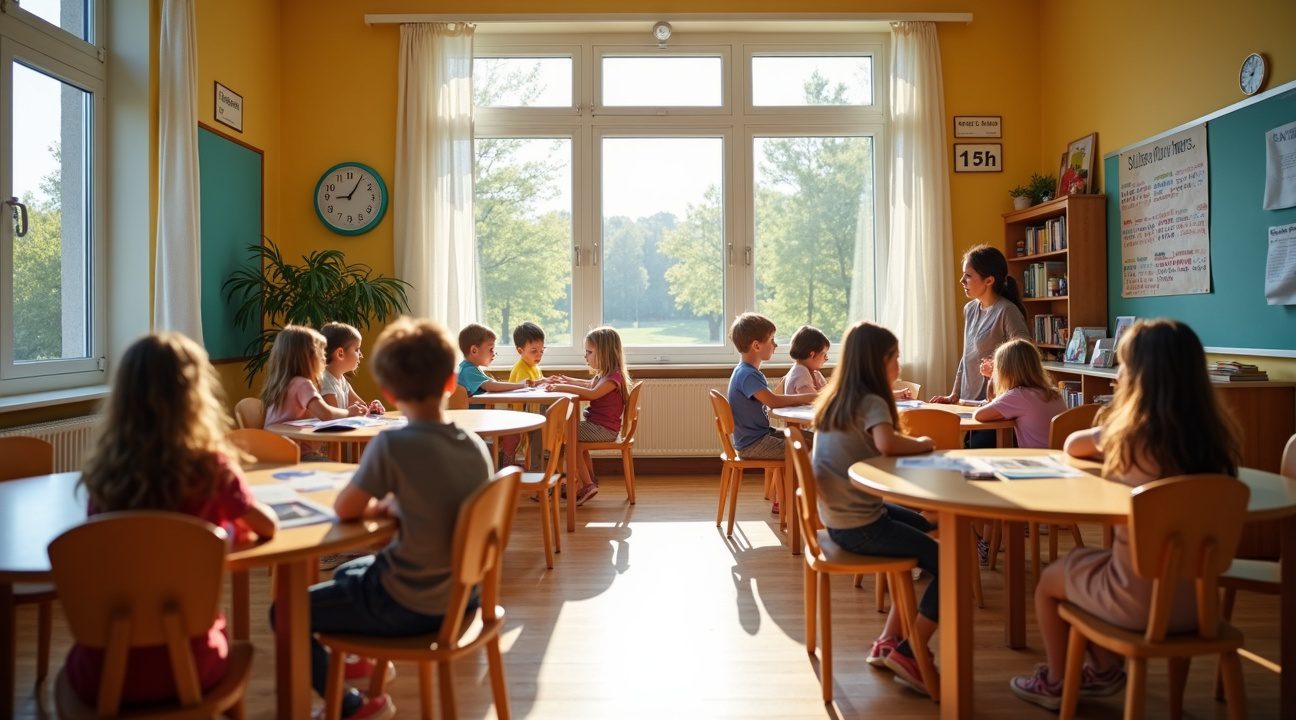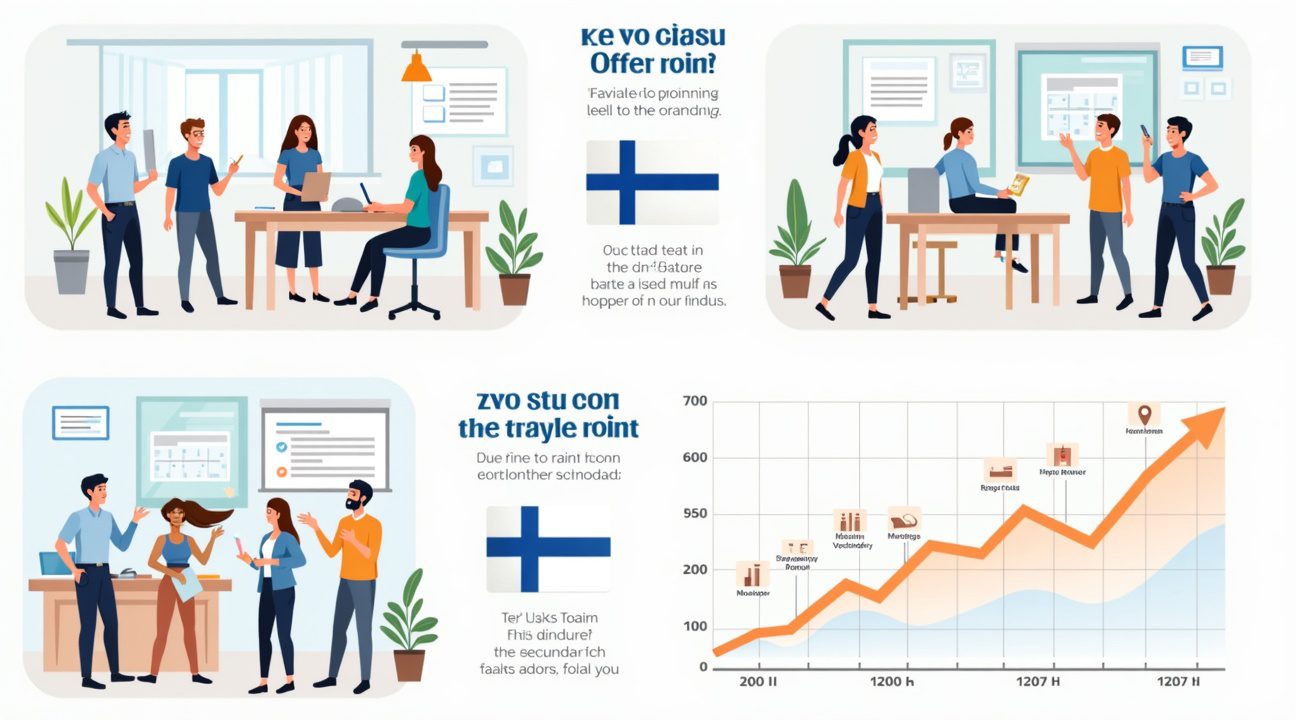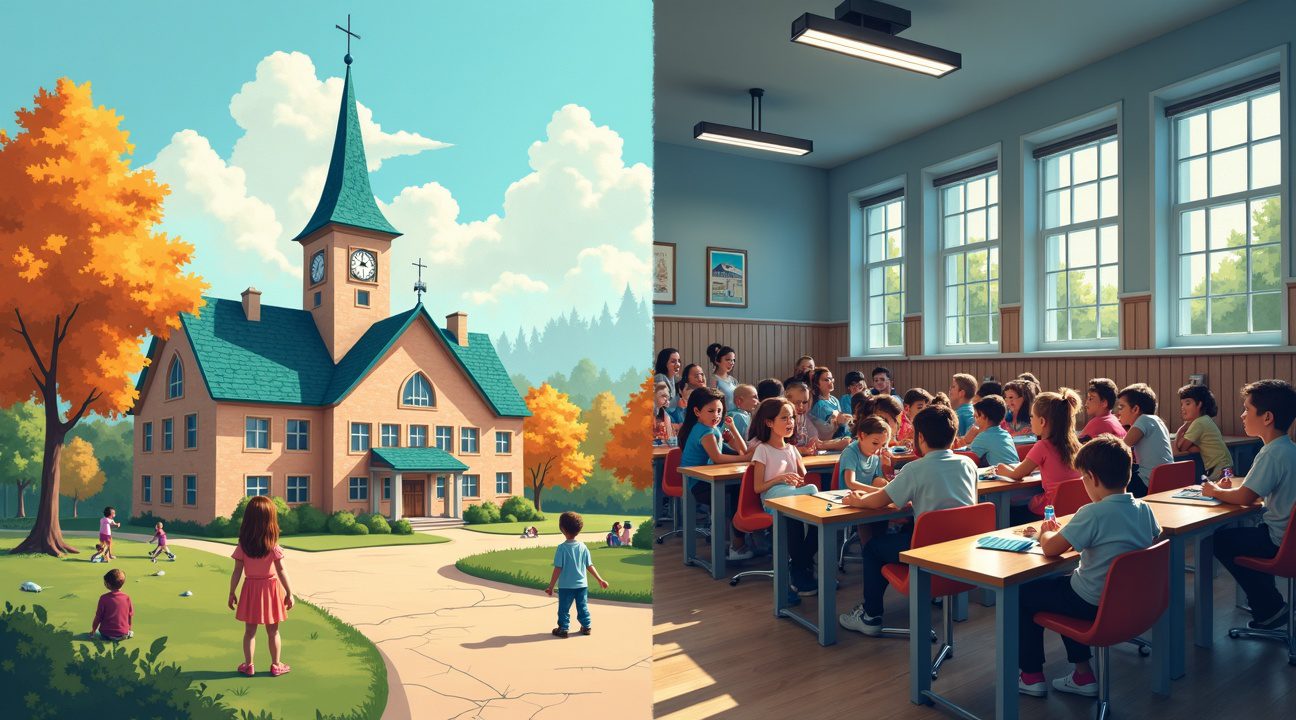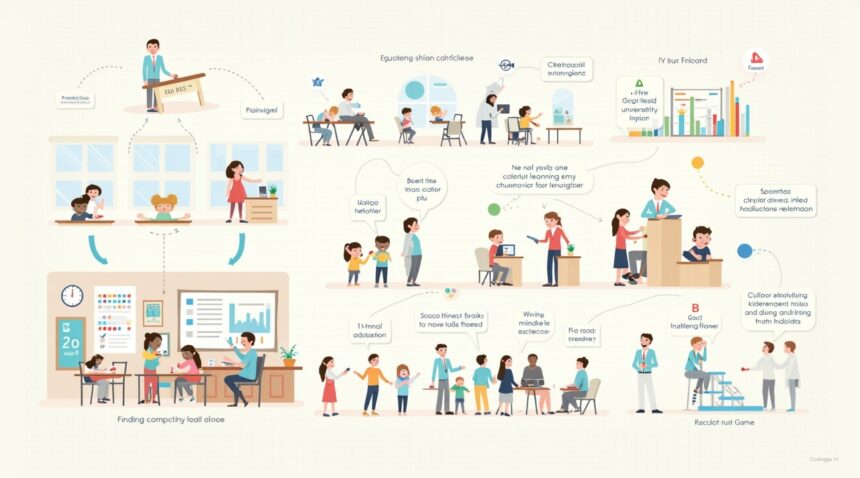Finland’s education system challenges traditional assumptions about academic achievement, with students attending school just five hours daily with regular 15-minute breaks yet consistently ranking among the world’s top performers. This approach demonstrates that educational excellence stems from quality instruction and thoughtful system design rather than extended classroom hours or intensive study schedules.
Key Takeaways
- Shorter school days with frequent breaks prevent mental fatigue and maintain student engagement, proving that quality of instruction matters more than quantity of classroom hours.
- The unified comprehensive system covering grades 1–9 eliminates disruptive transitions between educational levels, allowing students to develop lasting relationships with teachers and peers while building foundational skills.
- Students begin formal education at age 7, significantly later than most countries, allowing for greater emotional maturity and natural cognitive development without early academic pressure.
- 68% of upper secondary students choose vocational education, with 100% maintaining access to tertiary education upon completion, creating flexible pathways that remove stigma from non-academic tracks.
- Finland maintains a 29% university admission rate but achieves exceptional outcomes with 95% first-year retention and strong employment rates across all qualification levels, demonstrating how selectivity combined with support systems produces better results.
To explore more about how Finland’s system compares globally, visit this OECD profile on Finland’s education system.
How Finland’s 5-Hour School Days and Global Education Rankings Connect
Finland’s education system operates on principles that challenge conventional assumptions about academic achievement. Students attend comprehensive schools for just five hours daily with 15-minute breaks every hour, yet consistently outperform peers from countries with longer school days and more intensive academic schedules.
The Finnish comprehensive school system covers grades 1–9 without division between primary and lower secondary education levels. This unified approach eliminates the jarring transitions that disrupt learning in other educational systems. Children begin their formal education journey at age 7, significantly later than most international counterparts who start at ages 5 or 6.
Over 500,000 students attended comprehensive schools across more than 2,100 institutions in 2023, demonstrating the system’s widespread reach. These publicly funded schools operate without mandatory standardized testing during basic education, allowing teachers to focus on individual student development rather than test preparation. Students complete their compulsory education either after finishing the education syllabus or by reaching age 16.
The Continuity Advantage
The seamless progression through nine years creates educational stability that supports deeper learning. Students develop lasting relationships with teachers and peers while building foundational skills without the stress of adapting to new institutional cultures every few years. This continuity allows educators to implement long-term learning strategies that might be impossible in fragmented systems.
Finland’s approach demonstrates several key advantages:
- Students receive consistent educational philosophy and methodology throughout their formative years
- Teachers can track individual progress over extended periods and adjust instruction accordingly
- Learning objectives align naturally across grade levels without artificial divisions
- Social and emotional development benefits from stable peer groups and familiar environments
The later school starting age also plays a crucial role in student success. Seven-year-olds possess greater emotional maturity and readiness for formal academic instruction compared to younger children. This delayed start allows for more natural cognitive development and reduces early academic pressure that can negatively impact long-term learning outcomes.
Finland’s public funding model ensures equitable access to quality education regardless of family economic status. Without the pressure of standardized testing, teachers can implement creative pedagogical approaches that address diverse learning styles. This freedom enables educators to spend more time on conceptual understanding rather than rote memorization for examinations.
The shorter school days might seem counterintuitive to achieving high academic performance, but they reflect a deeper understanding of how children learn effectively. Regular breaks every hour prevent mental fatigue and maintain student engagement throughout the day. These educational insights challenge traditional notions about the relationship between time spent in classrooms and academic achievement.
Research consistently shows that quality of instruction matters more than quantity of classroom hours. Finnish teachers undergo rigorous training and enjoy high professional status, enabling them to maximize learning during those five daily hours. The education system prioritizes teacher autonomy and professional development, creating conditions where shorter school days can produce superior results.
Finland’s success also stems from cultural factors that support education outside school hours. Families and communities value learning, creating environments where students continue developing skills through reading, creative play, and family interactions. This holistic approach recognizes that education extends beyond formal classroom instruction.
The comprehensive system’s lack of academic tracking in early years ensures all students receive challenging instruction regardless of perceived ability levels. This inclusive approach prevents early labeling that can limit student potential and maintains high expectations for every learner. By age 16, when compulsory education ends, students have experienced nine years of consistent, high-quality instruction that prepares them for various post-secondary pathways.
Finland’s model proves that educational excellence doesn’t require extended school days or intensive testing regimens. Instead, it demonstrates how thoughtful system design, qualified teachers, and respect for child development can create conditions where all students thrive academically while maintaining healthy work-life balance.

Why 68% of Finnish Students Choose Vocational Education Over Traditional Academic Paths
Finland stands out globally with 68% of its upper secondary students enrolled in vocational programs, ranking 6th among 44 OECD countries in 2022. This impressive figure reflects a fundamental shift in how students and families view career preparation, moving away from the traditional assumption that academic routes provide the only path to success.
Comprehensive Opportunities Beyond Traditional Academics
The Finnish vocational system breaks down barriers that exist in many other countries. While vocational tracks elsewhere often limit students’ future educational options, Finland ensures 100% of vocational upper secondary students can access tertiary education upon completion. This achievement places Finland first among 39 countries in 2022, demonstrating how education quotes and philosophies about equal opportunity translate into practical policy.
Students don’t face dead-end choices in Finland’s system. They can pursue hands-on training in fields like technology, healthcare, or business while maintaining the option to continue to universities or polytechnics. This flexibility removes the stigma often associated with vocational education in other nations, where such programs are sometimes viewed as lesser alternatives to academic study.
Real-World Impact and Student Success
The numbers tell a compelling story about student engagement and outcomes. In 2023, Finland’s vocational education system served 347,730 students, with 68,470 qualifications attained during that year. The enrollment rate of 18-year-olds in vocational upper secondary programs reaches 41.5%, ranking 8th among 40 OECD countries in 2022.
These statistics reflect more than just educational policy success—they demonstrate how students respond when given meaningful choices. Finnish vocational programs combine theoretical knowledge with practical skills, preparing graduates for immediate employment while preserving their academic future. Students can enter the workforce with marketable skills and relevant experience, yet still pursue higher education if their interests or career goals evolve.
The Finnish approach recognizes that different students learn and thrive in different environments. Some excel in hands-on settings where they can immediately apply concepts, while others prefer traditional academic approaches. By ensuring both paths remain open and equally valued, Finland creates an educational ecosystem where students can make choices based on their interests and strengths rather than perceived limitations. This comprehensive approach helps explain why Finnish students achieve such strong outcomes despite spending fewer hours in traditional classroom settings compared to their international peers.
The Selective Higher Education System That Admits Only 29% of Applicants
Finland’s higher education system operates with a level of selectivity that stands out globally, accepting just 29% of applicants compared to more lenient admission rates in other countries. This exclusivity doesn’t represent a barrier but rather reflects the country’s commitment to quality over quantity in tertiary education.
Students enter Finnish universities at an average age of 24, two years later than the OECD average of 22 years. This delayed entry stems from a cultural acceptance of taking time to mature and gain life experience before committing to higher education. A remarkable 77% of new Finnish students take gap years before beginning their studies, nearly double the OECD average of 44%. These gap years often involve military service, travel, work experience, or simply time to reflect on career goals.
Academic Performance and Retention Excellence
Despite the selective admissions process, Finnish students demonstrate exceptional academic performance once enrolled. The completion rate for bachelor’s degrees within the expected timeframe reaches 49%, surpassing the OECD average of 43%. This higher completion rate reflects both the maturity of students who enter at an older age and the quality of education they receive.
The most striking indicator of system effectiveness appears in retention rates. Only 5% of new students in Finland discontinue their studies during the first year, while dropout rates in other countries range from 10% to 20%. Several factors contribute to this remarkable retention:
- Students arrive more mature and focused after gap years
- The selective admissions process ensures better program fit
- Financial support reduces economic pressure to abandon studies
- Strong academic support systems help students succeed
- Cultural emphasis on completing what you start
The Finnish higher education landscape consists of 14 academic universities serving over 168,000 registered students and 22 universities of applied sciences accommodating 56,400 admitted students as of 2023. This dual system allows students to choose between research-focused academic programs and practically-oriented applied sciences depending on their career goals.
Finland’s approach challenges conventional wisdom about accessibility versus quality in higher education. By maintaining selective standards while providing strong support systems, the country achieves both excellence and efficiency. Students who gain admission are more likely to succeed because they’ve demonstrated readiness and commitment through the competitive selection process.
The older average starting age actually becomes an advantage rather than a drawback. Students arrive with clearer goals, better study habits, and greater motivation to complete their programs. This maturity translates directly into higher completion rates and lower dropout statistics that benefit both individual students and the broader educational system.
Universities maintain their selective standards through comprehensive evaluation processes that consider not just academic performance but also motivation, life experience, and program fit. This holistic approach ensures that admitted students possess both the intellectual capacity and personal readiness to succeed in demanding academic environments.
The gap year culture provides additional benefits beyond simple maturation. Students gain real-world experience that enriches their academic studies, develop independence and confidence, and often discover or confirm their career interests before making significant educational investments. Educational insights from this approach influence policy discussions globally.
Finland’s selective higher education system demonstrates that limiting access can actually improve outcomes when combined with strong support systems and cultural values that emphasize preparation and commitment. The 29% admission rate doesn’t represent exclusion but rather ensures that students who enter are positioned for success. This approach contributes to Finland’s reputation for educational excellence while maintaining sustainable completion rates and minimizing resource waste from high dropout rates.
Strong Employment Returns for Education Despite Lower Tertiary Graduation Rates
Finland’s education system produces remarkable employment outcomes despite having fewer university graduates than other developed nations. Among 25-34 year-olds in Finland, only 39% hold tertiary degrees, falling short of the OECD average of 48%. This statistic might suggest Finland’s education system underperforms, but the employment data tells a different story entirely.
The employment rate gap between those with comprehensive education and tertiary qualifications reaches 46 percentage points in Finland, significantly exceeding the OECD average of 27 percentage points. This substantial difference highlights how Finland’s education system creates distinct pathways that lead to strong career outcomes across different qualification levels.
Employment Rates Across Education Levels
Finland’s employment statistics reveal the practical value of its educational approach. The employment landscape breaks down as follows:
- 46% employment rate for 25-34 year-olds without upper secondary qualifications
- 76% employment rate for those with upper secondary or post-secondary non-tertiary qualifications
- Even higher rates for those with tertiary education
These figures demonstrate how Finland’s comprehensive education foundation, built through those distinctive 5-hour school days with frequent breaks, creates a strong base for career success regardless of the final qualification level achieved.
The decline in NEETs (young people not in education, employment, or training) further validates Finland’s educational effectiveness. Between 2016 and 2023, Finland reduced its NEET rate from 16.3% to 12.5%, outpacing the OECD average decrease from 15.8% to 13.8%. This improvement suggests Finland’s education system successfully prepares students for either continued learning or immediate employment entry.
Finland maintains exceptionally low rates of young adults without upper secondary qualifications. In 2023, only 10% of young adults lacked these credentials, sitting four percentage points below the OECD average. This achievement reflects the effectiveness of Finland’s comprehensive education approach, which emphasizes foundational learning through educational knowledge rather than intensive study hours.
The employment gap data reveals something particularly striking about Finland’s system. While many countries focus heavily on pushing students through tertiary education, Finland’s approach creates strong employment outcomes for those who choose alternative paths. The significant employment rate difference between education levels suggests that Finland has developed effective vocational and technical education programs that complement its academic tracks.
Finland’s success challenges conventional assumptions about education intensity and outcomes. The country’s ability to achieve strong employment results with lower tertiary graduation rates demonstrates that quality education doesn’t require extended daily schedules or high university enrollment. Instead, Finland’s model shows how comprehensive foundational education, delivered through shorter but more focused school days, can create multiple pathways to economic success.
The data also suggests Finland’s education system effectively matches student interests and abilities with appropriate career paths. Rather than funneling all students through university programs, Finland appears to have developed a system where students can achieve economic success through various educational routes. This approach may explain why Finland maintains such strong employment outcomes despite having fewer university graduates than other OECD countries.
These employment statistics underscore how Finland’s distinctive educational approach—characterized by shorter school days, frequent breaks, and comprehensive learning—translates into real economic benefits for graduates across all qualification levels.

Declining Per-Student Funding Amid Growing Higher Education Enrollment
Finland faces a striking financial paradox in its higher education system that contradicts the country’s reputation for educational excellence. While Finnish students continue to benefit from shorter school days and frequent breaks at the elementary level, the tertiary education sector confronts mounting pressure from expanding enrollment and shrinking budgets.
Enrollment Surge Outpaces Funding Growth
The numbers tell a compelling story of imbalanced growth. Between 2015 and 2022, Finland witnessed a remarkable 12% increase in tertiary student enrollment, significantly outpacing the OECD average of just 5%. This surge reflects the country’s commitment to higher education access and the growing demand for advanced qualifications in an increasingly competitive global economy.
However, this educational expansion hasn’t been matched by proportional funding increases. Finland’s total higher education expenditure actually decreased by 3% in real terms during this same period, creating a sharp contrast with the OECD average increase of 14.2%. This divergence highlights a concerning trend where educational ambitions aren’t supported by adequate financial resources.
Per-Student Spending Takes a Dramatic Hit
The combination of rising enrollment and declining budgets has created a perfect storm for per-student funding. Finland experienced a devastating 13.5% drop in per-student expenditure, ranking as the second-largest decline among all OECD countries, with only Mexico experiencing a steeper fall. This dramatic reduction stands in stark opposition to the OECD average, which saw an 8.6% increase in per-student spending.
The implications of this funding crisis extend beyond mere statistics. Reduced per-student spending often translates to larger class sizes, fewer resources per student, and potentially diminished educational quality. For a country that has built its educational reputation on innovative teaching approaches, this financial constraint poses serious questions about maintaining educational standards.
Universities and higher education institutions must now accomplish more with less, stretching limited resources across a growing student population. Faculty-to-student ratios may suffer, research funding could face cuts, and essential educational infrastructure might receive delayed maintenance or upgrades.
Despite these challenges in higher education, Finland continues to prioritize its foundational education system. Public spending on basic education per pupil has actually risen, even as the total number of schools has decreased over the past decade. This investment strategy suggests that Finland remains committed to its proven elementary and secondary education model, which emphasizes shorter school days, regular breaks, and student well-being.
The contrast between basic and higher education funding patterns reveals Finland’s educational philosophy in action. While the country maintains its investment in the foundational years that have earned international acclaim, higher education faces the reality of doing more with diminished resources. This approach may reflect confidence that strong early education provides students with the skills and motivation needed to succeed even in resource-constrained university environments.
Finland’s higher education funding crisis occurs against a backdrop of changing educational priorities and economic pressures that many developed nations face. The challenge lies in maintaining educational quality and accessibility while managing fiscal constraints.
The sustainability of Finland’s current trajectory raises important questions about long-term educational outcomes.
- Can the country’s higher education system continue to produce skilled graduates and conduct meaningful research with declining per-student resources?
- Will this funding gap eventually impact Finland’s overall educational reputation and economic competitiveness?
Finnish policymakers face difficult decisions about resource allocation and educational priorities. The current approach of maintaining strong basic education funding while allowing higher education resources to decline per student represents a calculated risk that early educational excellence can compensate for later resource constraints.

Current Educational Population Profile Shows High Qualification Levels
Finland’s educational system produces remarkable results that extend far beyond the classroom. As of 2024, I find it impressive that 75.1% of Finland’s population aged 15 or older possesses an educational qualification, demonstrating the country’s commitment to lifelong learning and educational achievement.
Distribution of Educational Qualifications
The breakdown of educational attainment reveals interesting patterns across Finnish society. Upper secondary education represents the largest qualification category, with 39.8% of the population holding this as their highest level. This substantial percentage reflects Finland’s strong emphasis on completing secondary education before transitioning to higher education or the workforce.
Higher education achievements show equally strong participation rates:
- Bachelor’s degrees: 13.2% of the population
- Master’s degrees: 11.5% of the population
- Doctoral or equivalent qualifications: 1.2% of the population
While 24.9% of the population maintains basic education as their highest qualification, this figure includes individuals who may have chosen vocational paths or are still progressing through their educational journey. Educational insights from Finland continue to inspire global reform discussions.
Early Childhood and Private Education Trends
Finland’s educational excellence begins early, with participation in early childhood education now exceeding OECD averages for children both under and over three years of age. This early foundation supports the country’s later academic achievements and contributes to the strong qualification levels seen across the population.
Private tertiary education plays a significant role in Finland’s educational landscape. The percentage of students enrolled in government-dependent private tertiary institutions reaches 49%, placing Finland 5th out of 23 OECD countries in 2022. This high ranking indicates that private institutions complement public education effectively, providing diverse pathways for students to achieve their academic goals.
These statistics reveal how Finland’s educational approach creates multiple pathways for success while maintaining high standards. The country’s unique combination of shorter school days, frequent breaks, and comprehensive educational opportunities produces a highly qualified population that continues to perform exceptionally in international assessments.
Sources:


